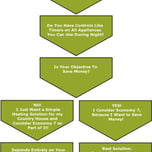
Get up to 4 quotes from our selected suppliers by filling in only 1 form

Save money by comparing quotes and choosing the most competitive offer

Our service is 100% free and with no obligation
- GreenMatch
- Blog
- Alternative Energy Sources
14 Alternative Energy Sources That Can Make a Difference

Alternative Energy Sources Are on the Rise
In the energy sector, fossil fuel sources have been the main energy source due to their relatively low price. However, our energy demand is predicted to rise in the future, and we can no longer rely on finite and polluting energy sources. In the last decade, we have seen a positive shift towards expanding our renewable energy capacity, both on a local and global level.
Solar panels, wind turbines set on and offshore, and hydroelectricity are some of the alternative energy technologies that will supply our future energy needs. Our dependence on natural gas and oil is the biggest reason for environmental damage and in the energy sector alone, is responsible for a 1.7% increase of carbon dioxide gases in our atmosphere. Hereby, alternative energy sources will be a main focus to prevent further climate change effects on our planet.
According to IRENA’s annual Renewable Capacity Statistics 2019, global renewable generation capacity reached 2,351 GW. The three alternative energy sources with highest percentage are:
- Hydropower accounts for 1,172 GW, which is about half of the total amount.
- Onshore and offshore wind energy come second with 564 GW.
- The capacity of solar power is slightly less — 480 GW, divided between solar photovoltaic and solar thermal power.
Alternative energy sources are forecast to expand in every sector by 2023. The electricity sector has the biggest share of 30%, and on the path of decarbonisation, electrification will become the main energy carrier, the bulk of it being generated by renewable energy.
Heating is second with 12% and the transport sector comes last with only 3.8% of alternative energy sources with room for improvement.
In the infographic below, GreenMatch highlights the current and future scope of alternative energy sources, and gives an overview of investments and future projections on our path to a sustainable future.

If you would like to use this infographic on your website, use the embed code below:
Is Investment in 2019 Slowing Down?
As per the planned implementation set by the Paris Agreement, cumulative investment in green energy needs to reach USD 110 tn., or around 2% (average) annual domestic product gross within that period.
The traction gained for alternative energy sources decreased the costs, especially the solar panel costs. According to REN21’s Renewables 2019 Status Report, global investment in new capacity reached USD 288.9 bln., excluding hydropower above 50MW.
The Chinese government ended their subsidy schemes because solar is now considered affordable and lead to a lack of solar deployment in China. As a result, numbers show 11% less investments in comparison to 2017.
Similarly, in April 2019, the Feed-in-Tariff scheme in the UK ended for new applicants who wish to utilise alternative energy.
Investment forecast foresees a stabilisation and growth in investments for the next review. Up to now, China is the biggest investor by country. Their drop in solar expenditure due subsidy significantly affected the total number, showing a clear dominance over the renewable energy market.
Future Alternative Energy Scope
Wider adoption of alternative energy sources depends on even more efficient renewable technologies and restructuring of the electric utility industry. With the use of renewables, generating clean energy is possible on a domestic level, with technology such as solar panels, air source heat pumps, and biomass boilers.
In order to utilise energy that is mostly weather or time-dependent to its full potential, we are yet to come up with better energy storage solutions.
Land Use and Growing Population
With population growth said to reach 9.7 bln. by 2050, wider use of large-scale solar farms might not be the ideal solution, as they take up a lot of land. Minimising land footprint is crucial or designing more efficient technologies, like wind energy converters.
Wind energy is currently one of the most important alternative energy sources in the UK, and roughly supplies about 4 mil. homes. Offshore wind is still underdeveloped due to costly maintenance and being situated in deep waters, but in the future we will be able to generate energy more efficiently from the oceans and deep waters.
Flaws in the design of current wind turbines limits the potential of wind power use, unable to reach high altitudes winds. Future airborne technology may lead the way with much more promising reach up to 500m, where winds are stronger.
One of the more costly, early-stage projects include sourcing solar energy from space. The prototype consists of optical reflectors, photovoltaic cells that convert sunlight into energy, and a circuit that converts the electricity into radio frequency. Then, an integrated antenna will transmit the energy back to Earth.
In the future, this innovative alternative energy source could meet the energy demands of our growing population without limitations, by using the constant sunlight from space.
Storing Green Energy
Efficient battery storage is vital for wider adoption for alternative energy sources. Solar Photovoltaic depends on direct sun exposure, meaning that sizable amount of energy goes unused or wasted because of a lack of in-built solar storage batteries.
In the future, hydrogen will be a driving energy source. Currently, the majority is produced from fossil fuels. However, surplus alternative energy is also used to produce hydrogen gas. Uses are versatile – hydrogen gas can be supplied to the natural gas grid, or by using fuel cells to be reconverted to electricity. Hydrogen might be widely used in the transportation sector, when we are able to come with less costly solutions for wider implementation of such alternative energy sources.
Hydrogen has the highest mass of density of any fuel, making it better for distribution and storage. Its stable chemistry also means that it can hold energy better than any other medium.
In the future, creating a supply and storage infrastructure will enable a more efficient use of hydrogen. Future plans for hydrogen include building an underground storage system where surplus wind energy, for instance, can be transformed into hydrogen through electrolysis.
Alternative Energy and Infrastructure
Our current global infrastructure is only adapted for fossil fuels. Building a new one will take years and a vast amount of resources. In recent years, off-grid technologies based on alternative energy managed to power remote locations in the form of mini or local grids.
Full decentralisation of the grid will bring opportunities for customers to sell electricity back to the grid and gain control over the needed and consumed energy. However, the UK is far from establishing full decentralisation due to the vast scale of transformation needed.
A number of businesses, however, can be considered pioneers in the off-grid restructure in the UK, such as UPS and some of the retail and supermarket giants.
The upscaling of alternative energy will open more jobs within the sustainable energy sector. Growth and implementation in all sectors will require years of planning and substantial investment.
In order to guarantee a future without further greenhouse emissions, we can start by placing more bans on future fossil fuel projects and more strict emission targets.

Valli has been writing well researched articles about renewable energy, sustainability and green technologies for GreenMatch since 2017. Her work has been published in various media such as Entrepreneur, Business Insider, Canadian Geographic, uSwitch, and eCycle.
 We strive to connect our customers with the right product and supplier. Would you like to be part of GreenMatch?
We strive to connect our customers with the right product and supplier. Would you like to be part of GreenMatch? 


